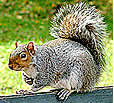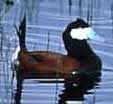How do invasive species cause harm?
Invasive species can be classified according to their activities and the damage they do. The following table shows one possible classification scheme.
Activity | Example | Activity | Example |
|---|
Benign or Beneficial species? |  Harlequin ladybird Harlequin ladybird
| Parasites or pathogens |  Dutch Elm disease Dutch Elm disease
(photo - UK Forestry Commision)
|
Competitors of native species |  Long- clawed crayfish, Grey squirrel Long- clawed crayfish, Grey squirrel
| Alterations to the biotic/ physical environment
or habitat. |  Coypu, Cane Toads Coypu, Cane Toads
|
Contributors to overgrazing |  Muntjac deer, rabbit Muntjac deer, rabbit
| Those which dilute genetic integrity of a species |  Ruddy duck Ruddy duck
|
Predators of native species | 
New Zealand flatworm*
| | |
The damage they do will depend on their activities but can broadly be summarised as damage by:
- Competition for resources
- Predation
- Herbivory (act of plant eating)
- Habitat alteration
- Disease
- Genetic effects such as hybridization (Natural hybridization can create genetic diversity and is important in evolution. Hybridization due to introduced species more often than not compromises genetic integrity of an existing species to the point of causing extinction).
N.B. this classification is a guide only and some invasive species, such as the harlequin ladybird, might fit into more than one section. When originally introduced into North America and Europe for pest control, the harlequin ladybird successfully controlled aphids on a variety of crop types but has now become extremely detrimental to native ecosystems. In the UK it has arrived by accident and is likely to have limited beneficial effects. In fact, there is concern over its impact on UK species of ladybird, with which it is likely to compete for resources, and even predate upon. It might therefore fit better into the competitor or predation section.
What can be done about it?
The Convention on Biological Diversity has broadly recommended a three-stage hierarchical approach.
- Stage 1 is to give a priority to prevent introductions of invasive non-native species.
- Stage 2 concerns the detection of newly-introduced invasive non-native species and, where appropriate, rapid action to prevent their establishment.
- Stage 3 concerns the long-term mitigation measures, such as containment or control, for established invasive non-native species.
Some UK case studies.

 Harlequin Ladybird
Harlequin Ladybird
*Photo by kind permission of Down Garden Services

What's your opinion?
Average rating




Not yet rated